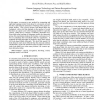Free Online Productivity Tools
i2Speak
i2Symbol
i2OCR
iTex2Img
iWeb2Print
iWeb2Shot
i2Type
iPdf2Split
iPdf2Merge
i2Bopomofo
i2Arabic
i2Style
i2Image
i2PDF
iLatex2Rtf
Sci2ools
ICASSP
2011
IEEE
2011
IEEE
Exploiting sparseness of backing-off language models for efficient look-ahead in LVCSR
In this paper, we propose a new method for computing and applying language model look-ahead in a dynamic network decoder, exploiting the sparseness of backing-off n-gram language models. Only partial (sparse) look-ahead tables are computed, with a size that depends on the number of words that have an n-gram score in the language model for a specific context, rather than a constant, vocabulary dependent size. Since high order backing-off language models are inherently sparse, this mechanism reduces the runtime- and memory effort of computing the look-ahead tables by magnitudes. A modified decoding algorithm is required to apply these sparse LM look-ahead tables efficiently. We show that sparse LM look-ahead is much more efficient than the classical method, and that full n-gram look-ahead becomes favorable over lower order look-ahead even when many distinct LM contexts appear during decoding.
| Added | 21 Aug 2011 |
| Updated | 21 Aug 2011 |
| Type | Journal |
| Year | 2011 |
| Where | ICASSP |
| Authors | David Nolden, Hermann Ney, Ralf Schlüter |
Comments (0)

